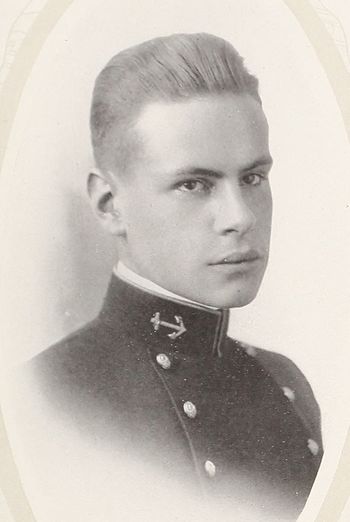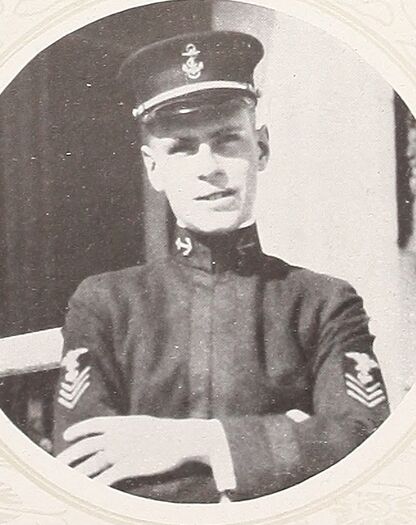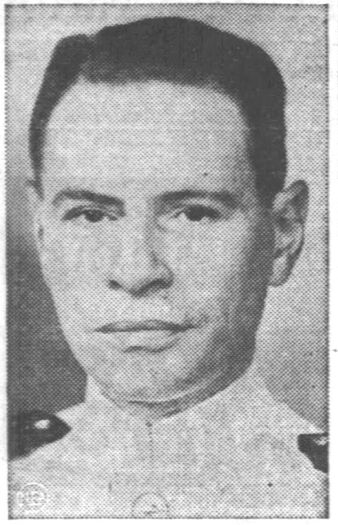GEORGE W. GROVE, LCDR, USNR
George Grove '15
Lucky Bag
From the 1915 Lucky Bag:
George Wilson Grove
Woodbury, New Jersey
"George"
IT'S a pleasure to write about George, but there are so many things to tell that it is hard to start. His good looks, his fussing, his athletic work, the "Masqueraders," and the Choir all present themselves; but first and foremost let us tell you of George Grove, gentleman. That represents a pretty good four year's work, don't you think? He is a man through and through. When George first decided to cast his lot with 1915 he was a quiet, well-behaved little fellow, showing all the traits which have made him what he is. Having trained himself to give his best—and a mighty good best it is—he expects the same from others, and he usually gets it, too.
He is a hard, clean worker in lacrosse, and accepted the managership as a chance for service. He has worked hard for that openly ridiculed but secretly admired organization known as the Choir and has worked hard for the "Masqueraders," but putting his heart and soul into his work is nothing new for Grove. The "Lucky Bag " also shows George's touch, and it is a better book for having Grove on the staff.
The ladies! They always have held a tender spot in George's heart. He was the only man who gave his speech at the Class Supper. His subject? "The Ladies," of course! George certainly does love the ladies and the ladies certainly do fall for George. We don't blame him, because we know the ladies; and we don't blame them, for we know George.
We are looking for big things from George, for he has the backbone that will take him far. With these he has the ability to gain a friend wherever he gains an acquaintance, and the friend always gains by knowing him.
Manager Lacrosse Team; Lacrosse Numerals; Choir (4, 3, 1 ); Masqueraders (4, 3, 2, 1); Log Staff; Lucky Bag Staff; Reina (3); Leader Glee Club.

George Wilson Grove
Woodbury, New Jersey
"George"
IT'S a pleasure to write about George, but there are so many things to tell that it is hard to start. His good looks, his fussing, his athletic work, the "Masqueraders," and the Choir all present themselves; but first and foremost let us tell you of George Grove, gentleman. That represents a pretty good four year's work, don't you think? He is a man through and through. When George first decided to cast his lot with 1915 he was a quiet, well-behaved little fellow, showing all the traits which have made him what he is. Having trained himself to give his best—and a mighty good best it is—he expects the same from others, and he usually gets it, too.
He is a hard, clean worker in lacrosse, and accepted the managership as a chance for service. He has worked hard for that openly ridiculed but secretly admired organization known as the Choir and has worked hard for the "Masqueraders," but putting his heart and soul into his work is nothing new for Grove. The "Lucky Bag " also shows George's touch, and it is a better book for having Grove on the staff.
The ladies! They always have held a tender spot in George's heart. He was the only man who gave his speech at the Class Supper. His subject? "The Ladies," of course! George certainly does love the ladies and the ladies certainly do fall for George. We don't blame him, because we know the ladies; and we don't blame them, for we know George.
We are looking for big things from George, for he has the backbone that will take him far. With these he has the ability to gain a friend wherever he gains an acquaintance, and the friend always gains by knowing him.
Manager Lacrosse Team; Lacrosse Numerals; Choir (4, 3, 1 ); Masqueraders (4, 3, 2, 1); Log Staff; Lucky Bag Staff; Reina (3); Leader Glee Club.
Loss
George was lost on June 13, 1941 when the plane he was aboard crashed into the Iraqi desert. He was en route to Bahrain to become the naval observer there.
Other Information
From Find A Grave:
Dallas Morning News, July 9, 1941 -
NAVAL OBSERVER DIES IN RAF CRASH OVER IRAQ DESERT
Washington, July 8 (AP) - The Navy Department reported Tuesday that Lieut. Commander George W. Grove, and observer with the Royal Air Force in Iraq, was killed last month in an airplane crash.Grove previously had been reported missing since June 13 on a Royal Air Force flight in Iraq.
The department said that information from the American Minister at Baghdad was that the body had been found in a wrecked plane on the desert and apparently all aboard the plane had been killed instantly. There was no information as to the cause of the crash.
The American Minister advised that funeral services for Commander Grove were held at Basrah on July 4.
The naval officer is survived by his wife, Mrs. Katherine Grove of Cornwall, Connecticut. [Also two sons; details below.]
He has a memorial marker in Pennsylvania. He is buried in Tunis, Tunisia.
From a blog post, "The First Casualty in Iraq":
… At the last minute, however, a fourth passenger talked his way onto the aircraft, one who surely piqued the young aviator’s curiosity. Not only was he an American, a rare sight in Iraq even in ordinary times, he was a naval officer — an odd duck indeed in a country with only 58 kilometers of coastline. The American was behind schedule and in a hurry, and not only did Iraq have few modern roads in 1941, RAF Intelligence judged them unsafe for travel by Westerners. Given the later indication that the American was aboard “by personal arrangement with the pilot,” it seems reasonable to conclude that F/O Arthur was happy to oblige him.
A Naval Reservist recalled to active duty, Lieutenant Commander George Grove supervised the loading of his baggage, keeping with him the briefcase that contained the cryptographic codes he was required to use in his new assignment as United States Naval Observer at Bahrain.
Grove, who’d been delayed while awaiting transit and the outcome of the Anglo-Iraqi War, must have been pleased at his luck in grabbing a hop to Basra — and on Friday the 13th, no less. He’d certainly made a sensible decision, talking Arthur into carrying him for what should have been a relatively brief, 2-hour flight to Shaiba.
Unfortunately, it was also a decision that would cost him his life and would make Lieutenant Commander George Wilson Grove, USNR, the first uniformed American to fall in the line of duty in Iraq.
…
After serving in destroyers during World War I, Grove left active duty in November 1920 to pursue a civilian business career. On October 5, 1940, Secretary of the Navy Frank Knox authorized the involuntary recall to active duty of 5,000 Naval Reservists, joining the 5,000 already on active duty. Leaving behind a wife and two sons in Rhode Island, Grove reported first to the Navy Department in Washington. He was posted to Manila, pending British approval of his assignment in Bahrain. Because Britain was historically the preeminent power in the Persian Gulf, and because the U.S. was not a belligerent in the conflict in the Mideast, diplomatic protocol gave London the right-of-refusal over the presence of any non-Allied military personnel in its areas of operation — especially those who would be performing “special duty.”
On March 29, 1941, the Secretary of State notified the American legation in Baghdad — the U.S. did not yet have full diplomatic relations with Iraq — that London had approved Grove’s assignment. The Minister-Resident (a legation did not rate an ambassador), Paul S. Knabenshue, was advised to expect Grove’s arrival and was given instructions for facilitating Grove’s mission.
Grove’s mission was to observe British anti-submarine operations in the Indian Ocean and gather intelligence on U-boat operations and the tactics, techniques, and procedures used to defeat them. With Britain’s position in the Middle East in jeopardy, Grove was also likely expected to maintain information on military operations east of the Suez Canal, then under threat by German Field Marshall Erwin Rommel’s Deutsches Afrikakorps.
…
Lieutenant Commander George Wilson Grove, USNR, became the first uniformed American lose his life in the line of duty in Iraq. He would not be the last.
…
It is sadly ironic that the first American service member to lose his life in Iraq, a country with only 58 kilometers of coastline, was a naval officer.
Lieutenant Commander George W. Grove, USNR, was recovered by British forces on Independence Day, July 4, 1941, and buried a day later in the British Imperial War Graves Cemetery at Basra, attended by an honor guard and firing party from HMS Seabelle, a converted yacht that served as Graham’s flagship, with “Taps” sounded by buglers of the Assyrian Levies.
From researcher Kathy Franz:
George was nominated to the Naval Academy by Congressman Loudenslager. George was a replacement for cadet Charles Curry (’11) who resigned after graduating.
George became a broker in New York City. He and his family traveled to Europe on several occasions.
He married Barbara Sargent on June 10, 1922, at St. John’s Church in New Haven, Connecticut. They had three children: Anne born 1923, George born 1925, and Michael born 1928. The couple divorced in August 1933. She then married Ludwig King Moorehead of New Canaan.
On August 20, 1935, George married Katharine Bacon Agate of Scarsdale, New York, at her parents’ home. They were in Naples, Italy, in September. After George’s death, Katharine married Dr. Henry Heyl.
In 1956, George’s son George Sargent Grove (’47) was executive officer of the USS Tweedy. His other son Michael Motte Grove (‘50) died on November 8, 2003, in Massachusetts.
George’s father was treasurer of the Argo Mills Company, a cotton mill, for many years. His mother Maud was a contralto soloist. After George’s father died in 1910, she gave a recital in Philadelphia attended by 500 people and later was a soloist for the Philadelphia Symphony Orchestra at the Temple Theatre in Camden. She later married Duncan Campbell.
Photographs
The "Register of Commissioned and Warrant Officers of the United States Navy and Marine Corps" was published annually from 1815 through at least the 1970s; it provided rank, command or station, and occasionally billet until the beginning of World War II when command/station was no longer included. Scanned copies were reviewed and data entered from the mid-1840s through 1922, when more-frequent Navy Directories were available.
The Navy Directory was a publication that provided information on the command, billet, and rank of every active and retired naval officer. Single editions have been found online from January 1915 and March 1918, and then from three to six editions per year from 1923 through 1940; the final edition is from April 1941.
The entries in both series of documents are sometimes cryptic and confusing. They are often inconsistent, even within an edition, with the name of commands; this is especially true for aviation squadrons in the 1920s and early 1930s.
Alumni listed at the same command may or may not have had significant interactions; they could have shared a stateroom or workspace, stood many hours of watch together… or, especially at the larger commands, they might not have known each other at all. The information provides the opportunity to draw connections that are otherwise invisible, though, and gives a fuller view of the professional experiences of these alumni in Memorial Hall.
January 1916
March 1918
January 1921
November 1940
LT William Pennewill '29
LT Finley Hall '29
LT John Yoho '29
LT Lance Massey '30
LT George Bellinger '32
LT Martin Koivisto '32
LT John Spiers '32
LT Daniel Gothie '32
LT Dewitt Shumway '32
LT Albert Major, Jr. '32
LTjg John Phillips, Jr. '33
ENS Frank Peterson '33
LTjg Charles Brewer '34
LTjg Walker Ethridge '34
CAPT Floyd Parks '34
LTjg Charles Ware '34
LTjg Frank Whitaker '34
LTjg Philip Torrey, Jr. '34
LTjg George Nicol '34
LTjg Victor Gadrow '35
LTjg John Powers '35
LTjg Allan Edmands '35
LTjg Roy Krogh '36
LTjg Porter Maxwell '36
LTjg Richard Hughes '37
LTjg Frank Henderson, Jr. '37
LTjg John Thomas '37
LTjg John Boal '37
ENS Harry Howell '38
ENS Eric Allen, Jr. '38
ENS James Ginn '38
ENS Oswald Zink '38
ENS Frank Case, Jr. '38
ENS Howard Fischer '38
ENS Edmundo Gandia '38
ENS Charles Reimann '38
ENS Howard Clark '38
ENS Roy Hale, Jr. '38
ENS Leonard Thornhill '38
ENS Osborne Wiseman '38
ENS John Eversole '38
ENS Jep Jonson '38
ENS Roy Green, Jr. '38
ENS Marion Dufilho '38
2LT James Owens '38
ENS William Brady '38
ENS Charles Anderson '38
ENS Carl Holmstrom '38
ENS Charles King '38
2LT John Maclaughlin, Jr. '38
ENS William Tate, Jr. '38
2LT Douglas Keeler '38
ENS Harry Bass '38
ENS John Kelley '38
ENS John Erickson '38
ENS William Lamberson '38
ENS Donald Smith '38
ENS Frank Quady '38
ENS Richard Crommelin '38
ENS Robert Seibels, Jr. '38
ENS Alphonse Minvielle '38
April 1941

The "category" links below lead to lists of related Honorees; use them to explore further the service and sacrifice of alumni in Memorial Hall.

